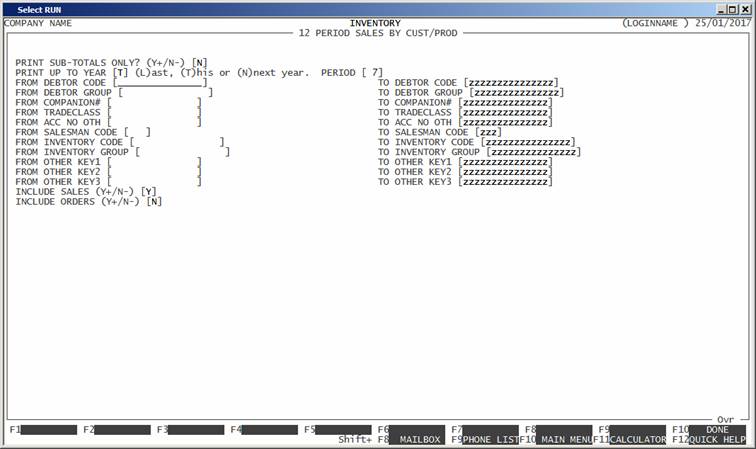HiFinance
5
SECTION
3.4.4.4I - 12 PERIOD SALES REPORT
USAGE: This is a special report designed to print the
sales and outstanding orders by Debtor, for a 12 periods. It is only available
if you have the Fuels option enabled.
DISCUSSION: When you enter this program, the following
questions will appear:
USE LONG FORMAT REPORT If you are using wide stationery, reply Y, otherwise reply N. This question will only be
displayed if the relevant option is set to A, see SECTION 7.1.2.
PRINT SUB-TOTALS ONLY?
(Y+/N-) [N] If you enter Y here, the report will contain no details, just sub-totals by Debtor
(Customer).
PRINT UP TO YEAR [ ]
(L)ast, (T)his or (N)next year. PERIOD
[..] This report is generated up to a period.
By default, this is the current period but you can change the period if you
wish.
Having entered the answers to the above, the screen
will appear as follows:

The report always prints by salesman, by debtor, by
product.
DEBTOR DEBTOR RANGE This is the Debtor’s code.
DEBTOR GROUP RANGE This is the Debtor Group.
DEBTOR OTHER KEY RANGE
(1,2 & 3) These may appear as a different literal
depending on how you have defined the field in SYSTEM PARAMETERS.
SALESMAN RANGE This is refers to the Salesman code, as it appears on the Debtor,
not the transaction.
INVENTORY CODE RANGE This is the Inventory’s code.
INVENTORY GROUP RANGE This is the Inventory Group.
INVENTORY OTHER KEY RANGE
(1,2 & 3) These may appear as a different literal
depending on how you have defined the field in SYSTEM PARAMETERS.
INCLUDE SALES If you replay Y here, invoices and
credit-notes will be included in the report. Otherwise, they will not.
INCLUDE ORDERS If you replay Y here, active sales orders
will be included in the report. Otherwise, they will not.
To start the report, press <Enter> through each field or simply press <F10>.
The report itself will detail, for each
Debtor/Inventory code, the net sales and/or outstanding orders in whole units.
Each line is totalled in a 13th column. Each Debtor is totalled,
immediately after the last Inventory line. Each Salesman is totalled. At the
end of the report, all columns are totalled.